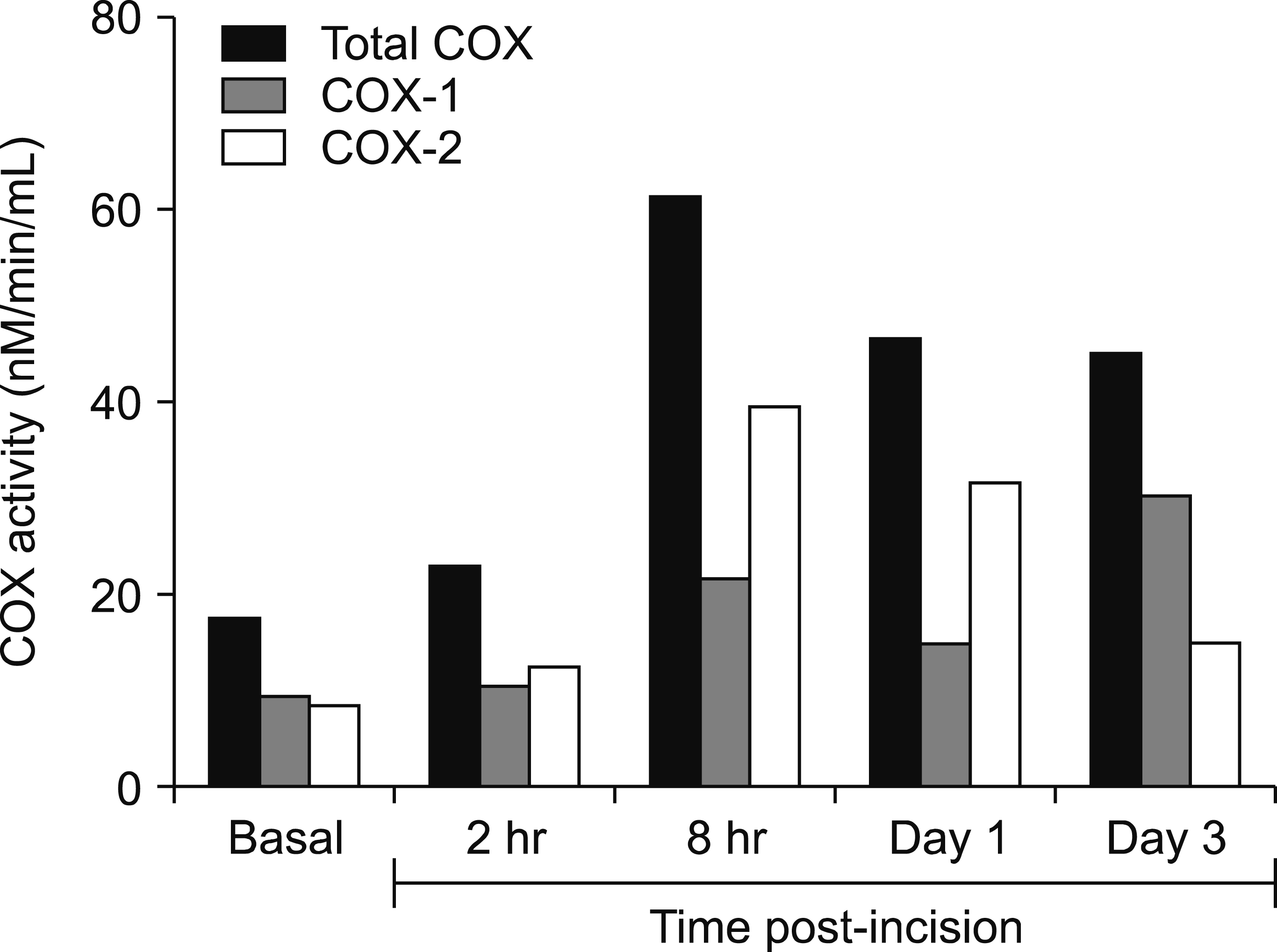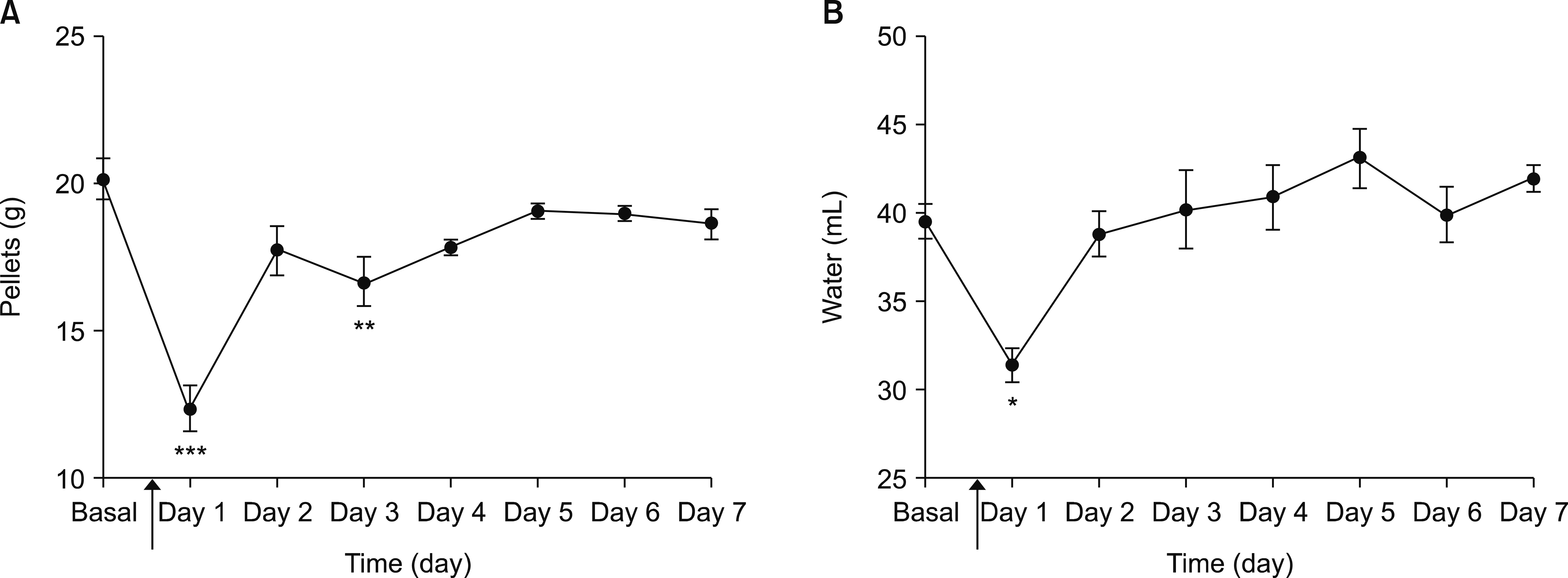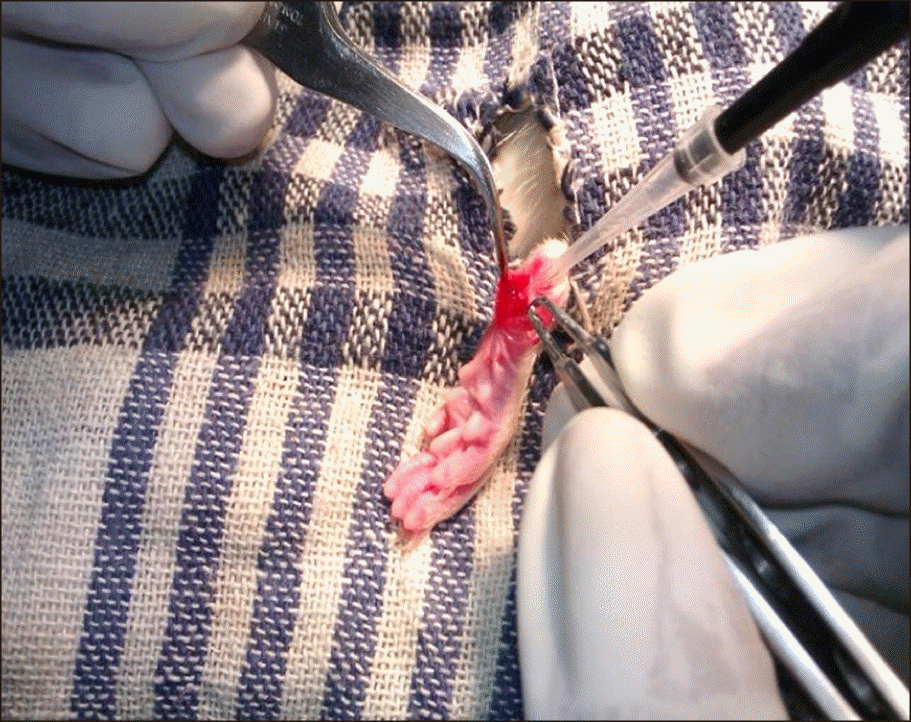1. Kumar V, Abbas AK, Aster JC. Robbins basic pathology. Philadelphia: Elsevier;2013. p. 29–73.
2. Dubois RN, Abramson SB, Crofford L, Gupta RA, Simon LS, Van De Putte LB, et al. Cyclooxygenase in biology and disease. FASEB J. 1998; 12:1063–73. DOI:
10.1096/fasebj.12.12.1063. PMID:
9737710.

6. Kim TJ, Freml L, Park SS, Brennan TJ. Lactate concentrations in incisions indicate ischemic-like conditions may contribute to postoperative pain. J Pain. 2007; 8:59–66. DOI:
10.1016/j.jpain.2006.06.003. PMID:
16949881.

7. Gautam M, Prasoon P, Kumar R, Reeta KH, Kaler S, Ray SB. Role of neurokinin type 1 receptor in nociception at the periphery and the spinal level in the rat. Spinal Cord. 2016; 54:172–82. DOI:
10.1038/sc.2015.206. PMID:
26690860.

8. Foster D, Davie EW. Characterization of a cDNA coding for human protein C. Proc Natl Acad Sci U S A. 1984; 81:4766–70. DOI:
10.1073/pnas.81.15.4766. PMID:
6589623. PMCID:
391571.

9. Joyce DE, Gelbert L, Ciaccia A, DeHoff B, Grinnell BW. Gene expression profile of antithrombotic protein c defines new mechanisms modulating inflammation and apoptosis. J Biol Chem. 2001; 276:11199–203. DOI:
10.1074/jbc.C100017200. PMID:
11278252.

10. Kumar R, Prasoon P, Gautam M, Ray SB. Comparative antinociceptive effect of arachidonylcyclopropylamide, a cannabinoid 1 receptor agonist & lignocaine, a local anaesthetic agent, following direct intrawound administration in rats. Indian J Med Res. 2016; 144:730–40. DOI:
10.4103/ijmr.IJMR_1402_15.

11. Bauer KA, Kass BL, Beeler DL, Rosenberg RD. Detection of protein C activation in humans. J Clin Invest. 1984; 74:2033–41. DOI:
10.1172/JCI111626. PMID:
6549015. PMCID:
425392.

12. Long GL, Belagaje RM, MacGillivray RT. Cloning and sequencing of liver cDNA coding for bovine protein C. Proc Natl Acad Sci U S A. 1984; 81:5653–6. DOI:
10.1073/pnas.81.18.5653. PMID:
6091100. PMCID:
391768.

14. Marlar RA, Kleiss AJ, Griffin JH. Mechanism of action of human activated protein C, a thrombin-dependent anticoagulant enzyme. Blood. 1982; 59:1067–72. PMID:
6803853.

15. Wijewardena A, Lajevardi SS, Vandervord E, Vandervord J, Lang TC, Fulcher G, et al. Activated protein C to heal pressure ulcers. Int Wound J. 2016; 13:986–91. DOI:
10.1111/iwj.12343. PMID:
25185858.

16. Xue M, Thompson P, Kelso I, Jackson C. Activated protein C stimulates proliferation, migration and wound closure, inhibits apoptosis and upregulates MMP-2 activity in cultured human keratinocytes. Exp Cell Res. 2004; 299:119–27. DOI:
10.1016/j.yexcr.2004.05.015. PMID:
15302579.

17. Bernard GR, Vincent JL, Laterre PF, LaRosa SP, Dhainaut JF, Lopez-Rodriguez A, et al. Efficacy and safety of recombinant human activated protein C for severe sepsis. N Engl J Med. 2001; 344:699–709. DOI:
10.1056/NEJM200103083441001. PMID:
11236773.

18. Yuksel M, Okajima K, Uchiba M, Horiuchi S, Okabe H. Activated protein C inhibits lipopolysaccharide-induced tumor necrosis factor-alpha production by inhibiting activation of both nuclear factor-kappa B and activator protein-1 in human monocytes. Thromb Haemost. 2002; 88:267–73. DOI:
10.1055/s-0037-1613197. PMID:
12195699.

19. Xue M, March L, Sambrook PN, Jackson CJ. Differential regulation of matrix metalloproteinase 2 and matrix metalloproteinase 9 by activated protein C : relevance to inflammation in rheumatoid arthritis. Arthritis Rheum. 2007; 56:2864–74. DOI:
10.1002/art.22844. PMID:
17763449.

20. Smith JR, Galie PA, Slochower DR, Weisshaar CL, Janmey PA, Winkelstein BA. Salmon-derived thrombin inhibits development of chronic pain through an endothelial barrier protective mechanism dependent on APC. Biomaterials. 2016; 80:96–105. DOI:
10.1016/j.biomaterials.2015.11.062. PMID:
26708087. PMCID:
PMC4706481.

21. Pichler L, Schramm W, Ulrich W, Varadi K, Schwarz HP. Antinociceptive properties of protein C in a model of inflammatory hyperalgesia in rats. Thromb Haemost. 1995; 73:252–5. DOI:
10.1055/s-0038-1653760. PMID:
7792739.

24. Brown C, McFarlane-Anderson N, Alexander-Lindo R, Bishop K, Dasgupta T, McGrowder D. The effects of S-nitrosoglutathione and S-nitroso-N-acetyl-D, L-penicillamine in a rat model of pre-eclampsia. J Nat Sci Biol Med. 2013; 4:330–5. DOI:
10.4103/0976-9668.116998. PMID:
24082727. PMCID:
3783775.

25. Wang Y, Cong Y, Li J, Li X, Li B, Qi S. Comparison of invasive blood pressure measurements from the caudal ventral artery and the femoral artery in male adult SD and Wistar rats. PLoS One. 2013; 8:e60625. DOI:
10.1371/journal.pone.0060625. PMID:
23577136. PMCID:
3618036.

26. Spofford CM, Ashmawi H, Subieta A, Buevich F, Moses A, Baker M, et al. Ketoprofen produces modality-specific inhibition of pain behaviors in rats after plantar incision. Anesth Analg. 2009; 109:1992–9. DOI:
10.1213/ANE.0b013e3181bbd9a3. PMID:
19923531. PMCID:
2869594.

27. Chaplan SR, Bach FW, Pogrel JW, Chung JM, Yaksh TL. Quantitative assessment of tactile allodynia in the rat paw. J Neurosci Methods. 1994; 53:55–63. DOI:
10.1016/0165-0270(94)90144-9. PMID:
7990513.

28. Hargreaves K, Dubner R, Brown F, Flores C, Joris J. A new and sensitive method for measuring thermal nociception in cutaneous hyperalgesia. Pain. 1988; 32:77–88. DOI:
10.1016/0304-3959(88)90026-7. PMID:
3340425.

30. Braz JM, Etlin A, Juarez-Salinas D, Llewellyn-Smith IJ, Basbaum AI. Rebuilding CNS inhibitory circuits to control chronic neuropathic pain and itch. Prog Brain Res. 2017; 231:87–105. DOI:
10.1016/bs.pbr.2016.10.001. PMID:
28554402.

31. Lavand’homme P, Wu C, Katz J. From acute to chronic postoperative pain. Pain 2018: refresher courses for the 17th World Congress on Pain. Gold MS, Pogatzki-Zahn EM, Wallace MS, editors. Washington: IASP Press;2018. p. 147–57.
32. Polanco-García M, García-Lopez J, Fàbregas N, Meissner W, Puig MM. PAIN-OUT-Spain Consortium. Postoperative pain management in Spanish hospitals: a cohort study using the pain-out registry. J Pain. 2017; 18:1237–52. DOI:
10.1016/j.jpain.2017.05.006. PMID:
28619696.
36. Futagami A, Ishizaki M, Fukuda Y, Kawana S, Yamanaka N. Wound healing involves induction of cyclooxygenase-2 expression in rat skin. Lab Invest. 2002; 82:1503–13. DOI:
10.1097/01.LAB.0000035024.75914.39. PMID:
12429810.

37. Köller M, König W, Brom J, Raulf M, Gross-Weege W, Erbs G, et al. Generation of leukotrienes from human polymorphonuclear granulocytes of severely burned patients. J Trauma. 1988; 28:733–40. DOI:
10.1097/00005373-198806000-00002. PMID:
2838646.

38. Cunha JM, Sachs D, Canetti CA, Poole S, Ferreira SH, Cunha FQ. The critical role of leukotriene B4 in antigen-induced mechanical hyperalgesia in immunised rats. Br J Pharmacol. 2003; 139:1135–45. DOI:
10.1038/sj.bjp.0705346. PMID:
12871832. PMCID:
1573940.

39. Guimarães FR, Sales-Campos H, Nardini V, da Costa TA, Fonseca MTC, Júnior VR, et al. The inhibition of 5-Lipoxygenase (5-LO) products leukotriene B4 (LTB
4) and cysteinyl leukotrienes (cysLTs) modulates the inflammatory response and improves cutaneous wound healing. Clin Immunol. 2018; 190:74–83. DOI:
10.1016/j.clim.2017.08.022. PMID:
28965882.

40. Foo H, Crabtree K, Thrasher A, Mason P. Eating is a protected behavior even in the face of persistent pain in male rats. Physiol Behav. 2009; 97:426–9. DOI:
10.1016/j.physbeh.2009.03.015. PMID:
19321150. PMCID:
2696032.

41. Hackett AF, Yeung CK, Hill GL. Eating patterns in patients recovering from major surgery--a study of voluntary food intake and energy balance. Br J Surg. 1979; 66:415–8. DOI:
10.1002/bjs.1800660613. PMID:
466026.

42. Fujita M, Fukuda T, Sato Y, Takasusuki T, Tanaka M. Allopregnanolone suppresses mechanical allodynia and internalization of neurokinin-1 receptors at the spinal dorsal horn in a rat postoperative pain model. Korean J Pain. 2018; 31:10–5. DOI:
10.3344/kjp.2018.31.1.10. PMID:
29372021. PMCID:
5780210.

43. Deane R, LaRue B, Sagare AP, Castellino FJ, Zhong Z, Zlokovic BV. Endothelial protein C receptor-assisted transport of activated protein C across the mouse blood-brain barrier. J Cereb Blood Flow Metab. 2009; 29:25–33. DOI:
10.1038/jcbfm.2008.117. PMID:
18841163. PMCID:
PMC2895315.

44. Carney EF. Inflammation: activated protein C inhibits inflammasome activation in IRI. Nat Rev Nephrol. 2017; 13:662. DOI:
10.1038/nrneph.2017.139. PMID:
28944779.

45. Riewald M, Petrovan RJ, Donner A, Ruf W. Activated protein C signals through the thrombin receptor PAR1 in endothelial cells. J Endotoxin Res. 2003; 9:317–21. DOI:
10.1177/09680519030090050801. PMID:
14577849.

46. Toltl LJ, Austin RC, Liaw PC. Activated protein C modulates inflammation, apoptosis and tissue factor procoagulant activity by regulating endoplasmic reticulum calcium depletion in blood monocytes. J Thromb Haemost. 2011; 9:582–92. DOI:
10.1111/j.1538-7836.2010.04177.x. PMID:
21166994.
47. Comp PC, Nixon RR, Esmon CT. Determination of functional levels of protein C, an antithrombotic protein, using thrombin-thrombomodulin complex. Blood. 1984; 63:15–21. PMID:
6317087.









 PDF
PDF Citation
Citation Print
Print




 XML Download
XML Download